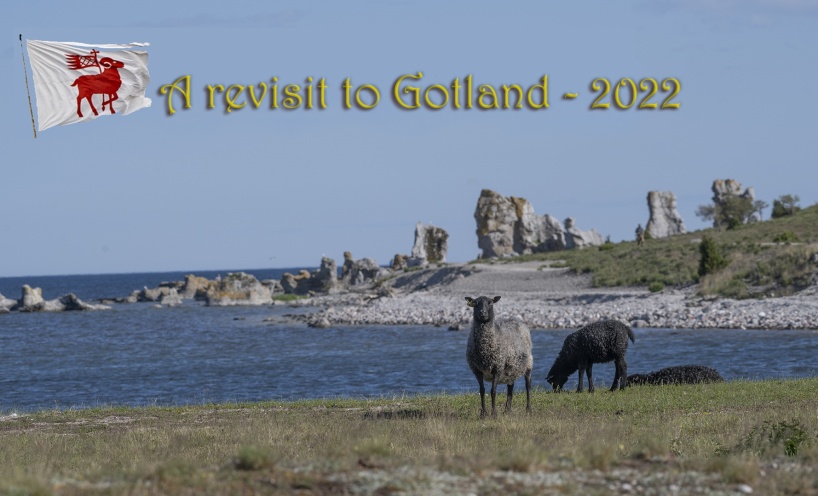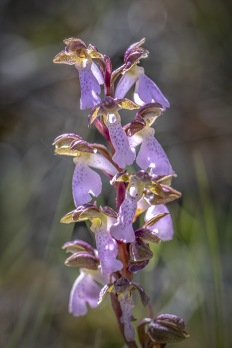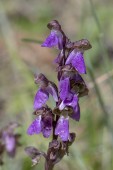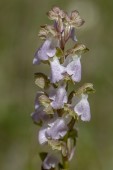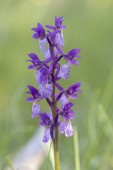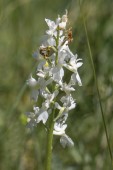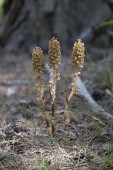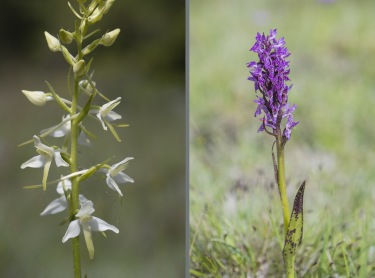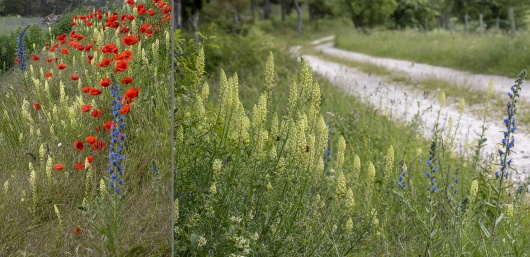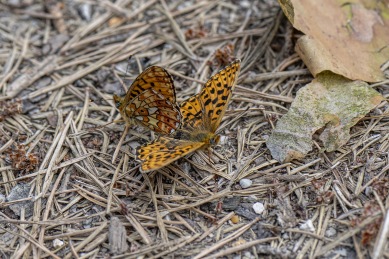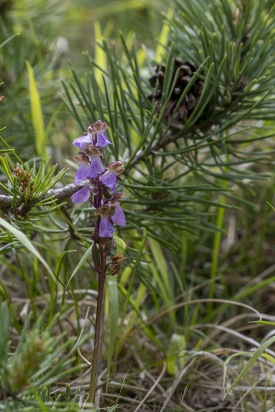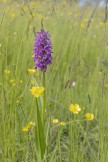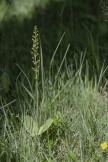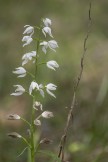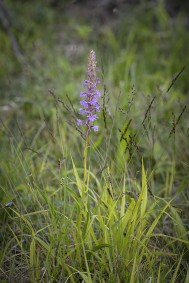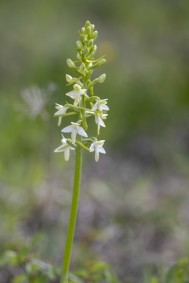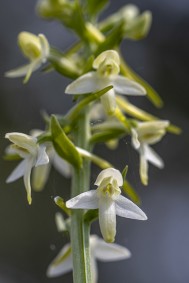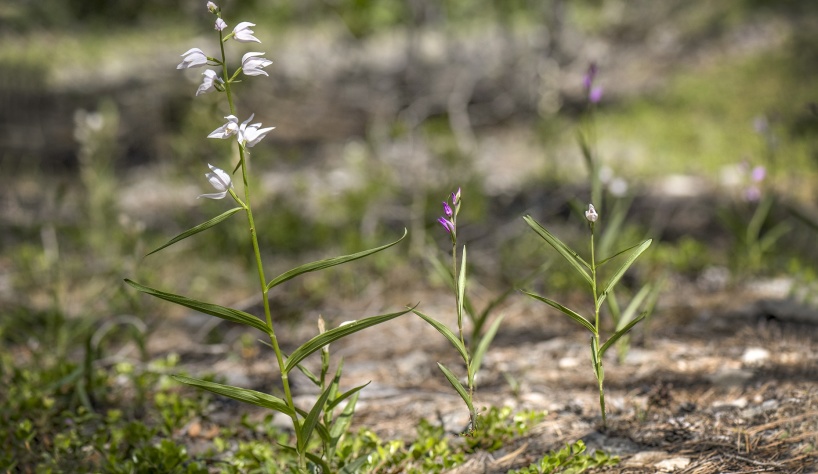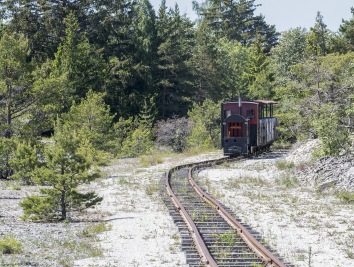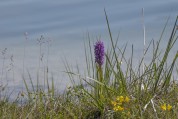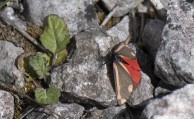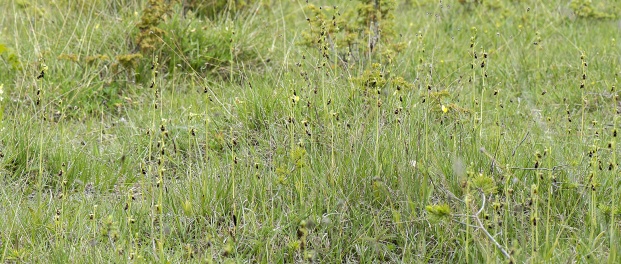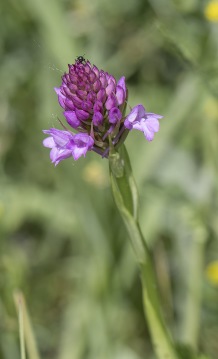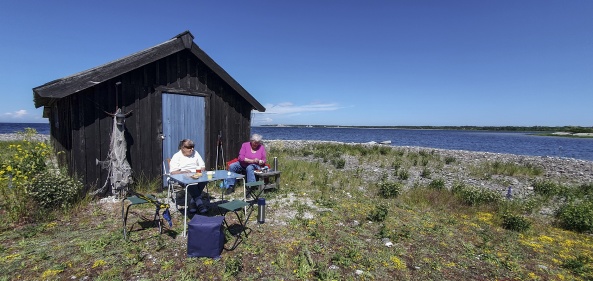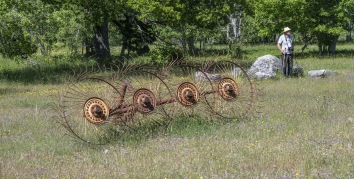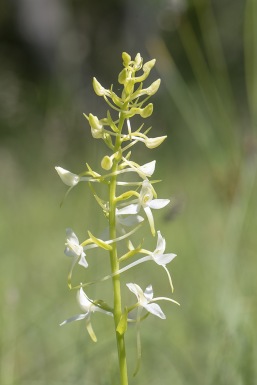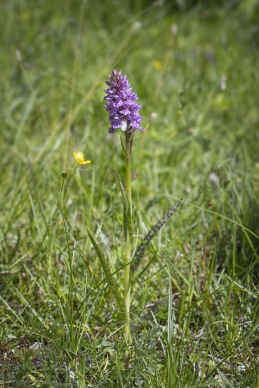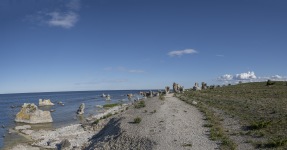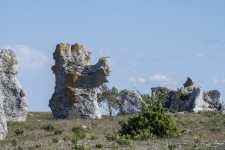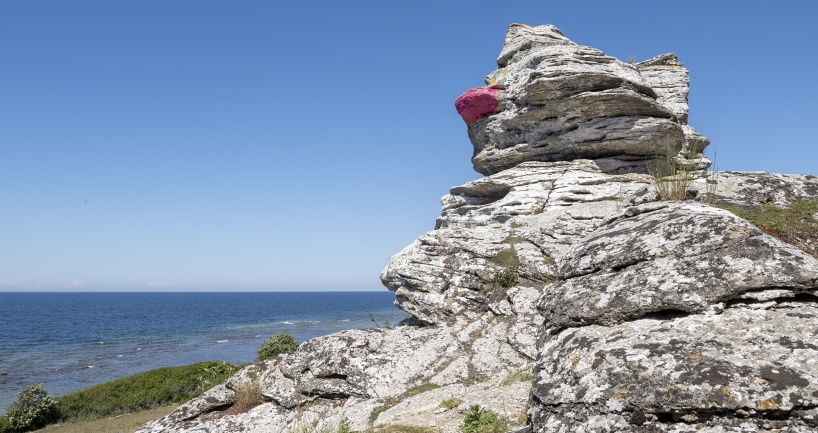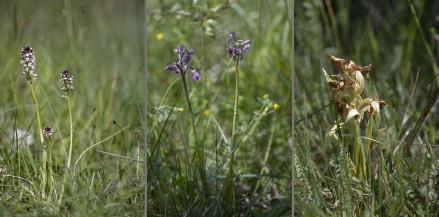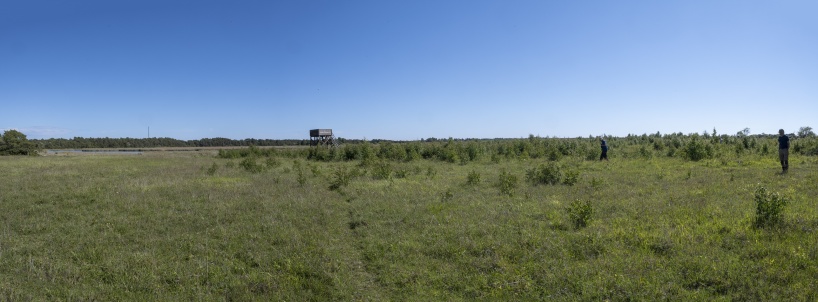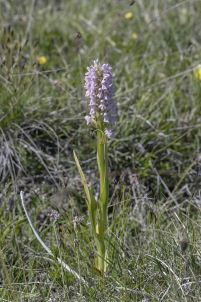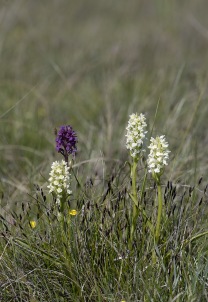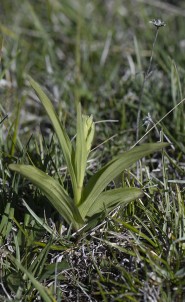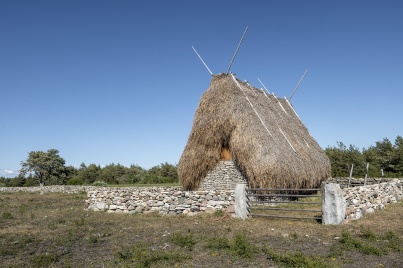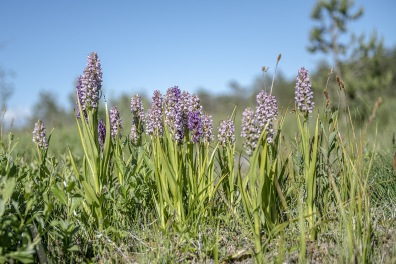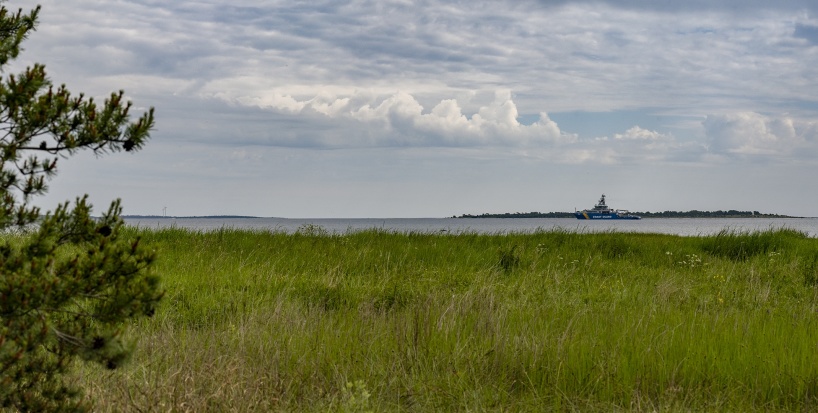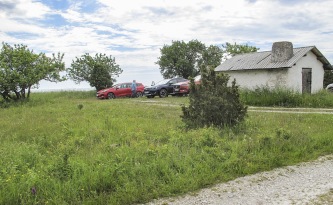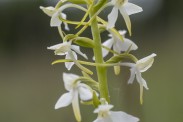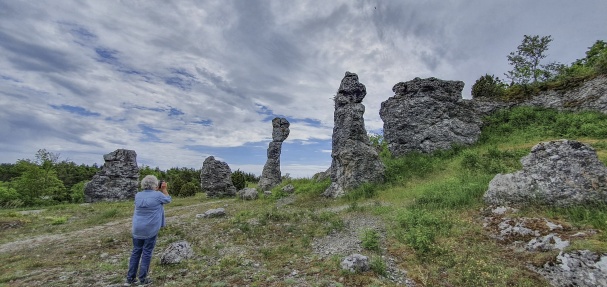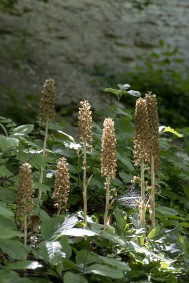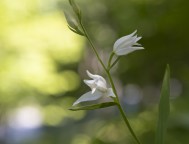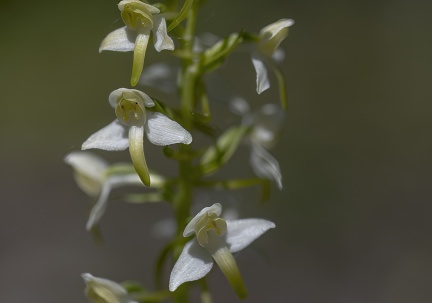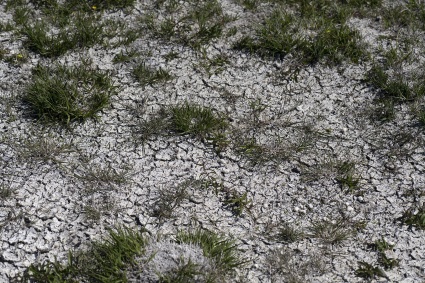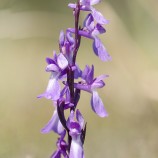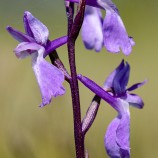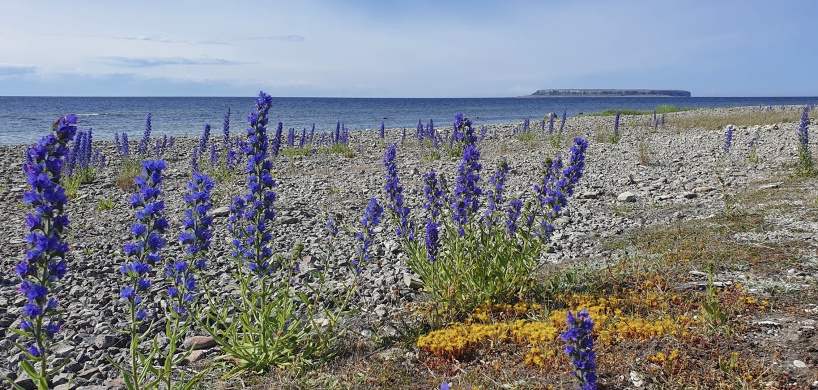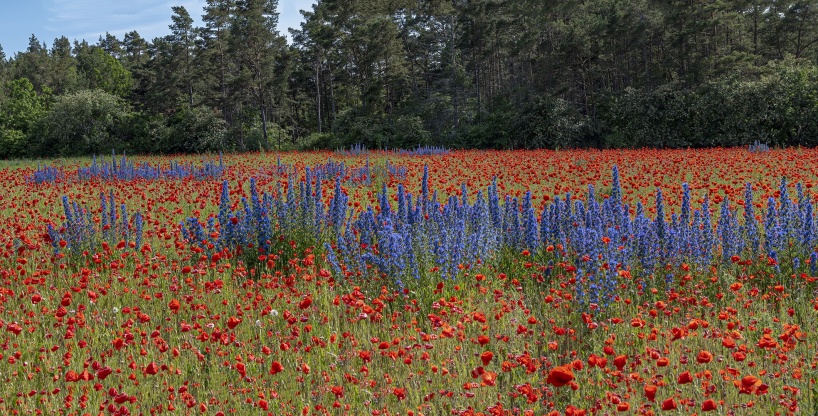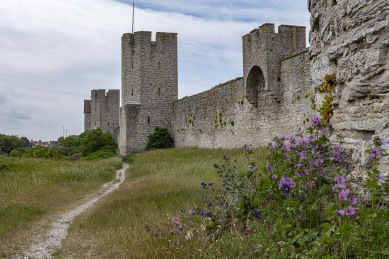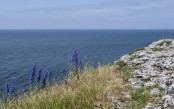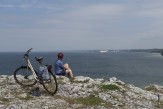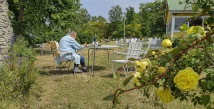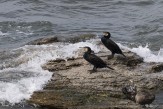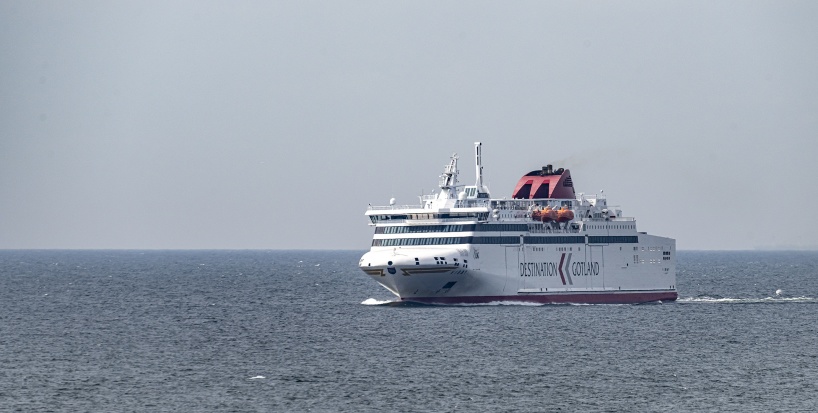Home | About Orchids | Orchid Areas | Galleries | Comments | Contact | Search
View from the island Asunden toward one of the biggest rauk field at Gotlands.
During autumn / winter 2021 it was decided that we would once again visit Gotland. This time some good old friends would also be there, so in the end there were 11 of us who boarded the Gotland ferry from Oskarshamn on May 12. Our stay was planned for June 12-18, a little less than a week.
Pre-booked accommodation was also this time at Visby Gustavsvik Stugby. Admittedly quite small rooms but for most of the stay we would still be outside so it felt OK. The booking as Bed & Breakfast worked perfectly. A good breakfast meant that we could start the days in good condition.
From what you could see, it seemed that spring was later here than at home. A lot of plants were in full bloom here, while at home it had already started to wither. Recently, however, it had been hot and very dry making even the wettest marshes now appear to be completely dried up. So, although we were happy with the trip, having nice weather throughout our short week, Gotland would probably need a lot of rain.
Day 1 (13 Juni 2022) Hall - Harudden
The area is part of Hall Hangvar, one of Gotland's largest, contiguous nature conservation areas.
Hall
Dag 1: Hall-Harudden
Dag 2: Bläse
Dag 3: Hoburgen
Dag 4: Eastern Gotland
Dag 5: Anacamptis palustris
Dag 6: Day of return journey
Orchids found
Typical environment for Orchis spitzelii. Sparse coastal forest with windswept pines.
One of the goals of the trip was to find Spitzel's Orchid (Orchis spitzelii) and since this is an early flowering species, flowers at the turn of May-June, our hope was to maybe find some good specimens if we started with the sites for these. One such site was at Hall where we walked the 1.5 km down to the beach areas. The sparse pine forest just inside the beach are suitable sites for Spitzel's Orchid. Our concern that they would have withered turned out to be wrong. Perhaps we had been helped by the earlier cold spring because here there were many of the species in good condition.
Admittedly, many had started to fall in the lower part of the spike, but enough flowers in good condition made us satisfied. I didn't count but estimate that I saw at least 50 plants.
The color of the flowers on Orchis spitzelii can vary quite a lot. Below you can see two color variants, one darker and one lighter than the usual color.
Otherwise, it was the orchids Orchis mascula that dominated the area. This one too with very variable colour as seen in the next three photos, one bi-coloured, one white with red dots (var. semialba) and one completely white (var. alba). Other species seen here were Cephlanthera rubra and Neottia nidus-avis. Another species seen here (but not pictured below) was Cephalanthera longifolia.
On the way back to the cars we discovered that there were orchids in a small bog right next to our path. It turned out to be another couple of new species for the day, Platanthera bifolia subsp. bifolia (or perhaps is this subsp. latiflora?) and Dactyloriza incarnata subsp. cruenta. Both species grew in abundance together with Primula farinosa.
T the left Platanthera bifolia ssp. bifolia, and right Dactylorhiza incarnata ssp. cruenta, with the typical characteristic, dotted leaves with dots on both the upper and lower sides of the leaves.
A few kilometers further on, a road goes to the left towards Harudden. Just before you reach the beach area itself, there is a small parking lot. Here on the slope among the flowering Early Purple Orchid, we had our packed lunch before exploring the site. Also from this area there were Orchis spitzelii reported and it didn't take long before we found some, although not nearly as many as at Hall. Possibly the drought had an effect because it was very dry in the coastal forest.
In the marsh just inside the beach, which was also completely dried up, we found a lot of Dactylorhiza incarnata.
Orchis spitzelii
Other orchids seen here were large specimens of Dactylorhiza incarnata, picture 1, Neottia ovata, picture 2, and Cephalanthera longifolia, picture 3.
We saw quite a few butterflies during our trip (there seemed to be few of them this year). Below are small blue and common blue butterfly (probably).
Bonus stop
On our way back we made a stop after a few kilometers. Last time we were on Gotland, there were a lot of orchids in the sparse pine forest. It turned out that there was a lot to find this time too. A different observation was made when we spotted a golden eagle circling above us.
Orchis militaris was one of the species seen at this site. Along with Dactylorhiza incarnata, it was not unusual to see them in large numbers in roadside ditches here and there.
A nice observation was made here before we started to explore the site when we discovered that a golden eagle was circling above us.
This was the last stop for the day. Time flies when you're having fun. There is much to see and discover in Gotland's nature.
The hybrid to the left and the two parents, here with small specimens, in the center and to the right.
Also on this second day, we chosed to go north. This time to the northeastern part of Gotland, east of the bay that splits the northern end of the island. Here are two of the sites I found most interesting on Gotland, partly the road through the pine forest from Bläse out towards the lime quarry which has lots of white and red forest lily, partly Hässleänget, a Gotland meadow usually with a lot of orchids.
Bläse
From Bläse we chose the gravel road out towards the former lime quarry northeast of Bläse. In the sparse pine forest along the way out there are large amounts of Cephalanthera rubra and longifolia respectively. Here we also found the hybrid between these, Cephalanthera x otto-hechtii.
A little to the east of the road there is a marsh, Gridhammarskärret, from where Anacamptis palustris has been reported. However, we did not go that far, but only down to the now water-filled quarry. Here we found our first Dactylorhiza incarnata subsp. ochroleuca for this trip.
There is a narrow-gauge railway from Bläse out to the limestone quarry which now transports tourists who want to experience the landscape.
The main goal for this trip was to find the hybrid between Cephalanthera rubra and longifolia. However, it turned out that there were a lot of those in the sparse forest together with hundreds of Sword-leaved and Red Helleborine. As is often the case with hybrids, the color varied a lot on this one as well (pictures 1-3). There were also quite a few Epipactis atrorubens (picture 4) in the stony, gravelly forest floor. The entire forest grows on old slag products from the lime quarry. This Epipactis probably had at least a week or so until flowering.
A nice find down by the "lake", which was made up of the water filled quarry, was Dactylorhiza incarnata subsp. ochroleuca (picture 5). However, most of what was seen here on the shore were Dactylorhiza incarnata subsp. incarnata with many colors (picture 6). The last picture shows a cinnabar moth.
Bonus stop
We returned same way from Bläse as we came. A few km further on there was an area with an incredible amo-unt of orchids at our last visit and so also now. Without comparison, it is the densest stand of Ophrys insectifera I have ever seen. 100s at an area of about 15-20 square meters (see picture).
We spoke to the owner of the house opposite the area. He was interested in orchids and told me, among other things, that in the summer he had lots of Anacamptis pyramidalis at his lawn. We also managed to find some of these but at this time only with a few flowers open.
Other species growing in this small area between the road and the beach were: Cephalanthera longifolia, Neottia ovata, Orchis militaris, Dactylorhiza incarnata ssp. incarnata and ssp. ochroleuca.
PS: I got a message from the house owner, a while after we got home, telling me that almost all orchids were uprooted. Most likely it was cranes that had done this. It is known from other places that the cranes can uproot orchids, biting off and eating the root tubers but leaving the plant itself behind.
Anacamptis pyramidalis
Hässlänget
Back on the road, we set course for our next destination, Hässleänget. It is a typical Gotland "meadow" with a nice leafy environment. This meadow has both wetlands and dry slopes, which makes the area very species-rich. At the time of our visit it was very dry everywhere and not nearly as many orchids as on my last visit. But we found a number even now, for example our trip's only Dactylorhiza traunsteineri.
View from the dryer part of the meadow.
Our plan was to go to Bräntings haid and Hoburgsmyr but instead we chose to go down to Nybroviken to find Dactylorhiza majalis subsp.baltica if possible. A species that you need to go to Gotland to see in Sweden. There are supposed to be some plants on a site near Piteå, but uncertain if these are still there.
Nybroviken
After a few miles and the last part on narrow dirt roads towards Asunden, an island in Nybroviken, we arrived to the site for Dactylorhiza majalis subsp. baltica. No problem finding those, they were in abundance together with D. incarnata subsp. incarnata and some subsp. cruenta.
In the marsh at Nybroviken there were very large specimens of D. incarnata subsp. incarnata. Here, as at most other sites we saw, the flower color varied quite a bit.
Asunden is a largely bare island at the entrance to Nybroviken. It is about 2x1 km and there you will find one of Gotland's largest area with rauks. Only the imagination puts an end to what you can find there: A Janus face (image 2 below), a camel or perhaps a rhinoceros.
A bridge crosses from the "mainland" to the island and in the shallow water there are a lot of birds: Tern, mother swan with young and fishing heron.
After the visit to Asunden, we decided it was time to return to Gustavsvik again. But noted that another pleasant day had passed with great speed.
Day 3 (15 Juni 2022) Hoburgen
We started the day by, after driving a few miles, searching in a dry area outside Vamlingsbo. Very dry! In the edges towards the forest outside the area there was apparently some moisture because here it was greener and it was also here that we found orchids. Now we came across Neotinea ustulata for the first time, a species that we had expected to find earlier.
The last part of our journey towards Hoburgen we chose to drive a smaller road along the coast to Hoburgen. We turned off the main road a few km after Vamlingsbo at a sign "Vacker väg till Hoburgen". And it is a beautiful landscape along the coast here. We therefore chose to take our lunch break here to really enjoy the beautiful view and the lovely weather.
View of Muskmyr. Here there are also open lakes at the edges of the marsh with interesting bird life. Hence the bird tower.
About 6 km from Hoburgen there is a small parking lot for visitors to the reserve. There is a path that goes around the entire bog, but we chose to botanize on the nearest side. It was dry here too so walking around in the bog was no problem. There were a lot of orchids in the wettest areas. However, nothing new for the trip. In addition to the species below, Platanthera bifolia, Neottia ovata and Orchis militaris were seen.
Muskmyr was the last stop this day. The 100 km from Gustavsvik to Hoburgen and back takes time on Gotland's roads. But even during the transport stretches there were things worth stopping for.
If you look carefully when driving, you can see large groups of orchids in many places on the edges of ditches along the road. Presumably, the availability of moisture means that there sometimes are abundant and large populations in these mini-environments.
These Dactylorhiza incarnata are a small part of such a site that made one slow down.
Today's trip, which we called "East Gotland", was dedicated to the search for Dactylorhiza majalis subsp. elatior. We started by looking just outside Slite, in a marsh, for a recross of subsp. elatior with (probably) D. fuchsii because these got spotted leaves. Also subsp. elatior, it is believed, has a hybrid origin. However, we did not manage to find that hybrid here.
We therefore continued on to Gylviken where there would be a site for D. majalis subsp. elatior. Once there, it turned out that not only were there plenty of elatior, but also the previously sought-after spotted-leaf hybrid.
Down by Gylviken we parked at some old fishermen's cabins (?).
Below are pictures of what was seen at Gylviken. From left Dactylorhiza majalis subsp. elatior, photos 1 and 2. The next two photos show the spotted leaf hybrid. Image 5 is probably a pure D. fuchsii. This should be a common species on the island but as we didn't see it on any other sites, it probably wasn't flowering yet. Some single Anacmptis pyramidalis had also just started flowering. The last picture shows a Platanthera bifolia with a very long spur (and sparse spike) which makes it likely to be subsp. latiflora.
On our way back, out towards the main road, we noticed that there was a lot of Ceph-alanthera longifolia in the pine forest along the road. Of course this caused an extra stop because between the pines stood the most beautiful specimen of the species I have ever seen, in perfect condition as well.
Cephalanthera longifolia
The next destination for the day was Vikalu. Previously, Dactylorhiza majalis ssp. elatior was considered to be two different orchids until a scientific investigation and description was made, partly there was "Gylviksnycklar" which we just had seen, partly another one which grow here at Viklau and therefore named "Viklaunycklar". These are now considered the same species.
Unfortunately, we were unable to find any such here despite diligent searching.
Folhammar rauks
Folhammar rauks just north of Ljugarn is impressive both in terms of size and shape of the rauks, well worth a visit. A few of us chose to drive up to this before heading back home after another interesting day.
View from Krakvät nature conservation area with Anacamptis palustris in the foreground.
Now we had reached the last excursion day of our journey. We had already decided from day one that this route should be at the last of our days. Anacamptis palustris, which we hoped to find this day, is usually noted as flowering in late June and July. So hoping to find these flowering we wanted to do this as late as possible.
Klinteberget
But before searching for Anacamptis palustris, we would visit a site for Cephalanthera damasonium, another species we didn't come across during the other days. The site is located on the steep slopes of Klinteberget. We chose to drive up the "mountain" and from there go down the slope. As usual, there was lot of the sought-after orchid here. In addition also a lot of Cephalanthera rubra.
Äsketräsk
In the Nordic region, it is only at Gotland that Anacamptis palustris can be found. How it ended up here is unclear. Otherwise, it is found in some area in northern Germany as well as scattered occurrences in southern Europe.
For this day we had two sites where this orchid usually is found. Partly Äsketräsk, about which it is said that there it usually blooms earliest. Partly Krakvät, a marsh just inside the coastline.
We started with Äsketräsk, which is a small part of the former huge wetland area of Mästermyr, but which today is mostly excavated and is now arable land.
Just like the other wetland sites we visited, this one was completely dried out. In what usually use to be a marsh, which we found after a bit of searching, it crunched under our feet and no Anacamptis was seen. Some previously found species were also here, for example a Platanthera chlorantha. Platanthera chlorantha
Krakvät
Even the marsh at the next site, Krakvät, was completely dried up. But luckily there were still a lot of flowering Anacamptis here.
Here there would have been water between the tufts of grass. Now it looked almost like pictures from a desert area.
Below are four pictures of Anacamptis palustris and a last picture that shows Platanthera bifolia subsp. bifolia which also was found in large numbers here.
Anyone who has seen Anacamptis palustris in the Mediterranean area is probably wondering if it is the same species as here at Gotland. Here they usually are no more than half of the high than the plants there. Anyhow, it is considered to be the same species.
Now our excursions were over, for this time, maybe one should add, because who knows what can happen another year.
Some of us chose to make our way home via Ekstakusten, a coastal strip on the west side where the road practically follows the water's edge for a few kilometers. This is an experience in good weather and can be highly recommended.
Many can certainly attest that Gotland is worth a visit. The above view I don't think you can find anywhere else so I couldn't resist including it here. A view from our road from Ekstakusten up towards the main road.
The ferry back to Oskarshamn would not leave until the afternoon. We therefore had plenty of time to look at other parts of Gotland. Everyone now chose what suited them. We ourselves chose to look a little closer at Visby and the immediate surroundings.
The old wall around Visby is an impressive building.
A trip out to Högklinten can make you gasp when you get close to the edge. Here there is nothing to see at the horizon. However, some are more daring than others (picture 2). Picture 3: View towards Visby and the harbour. Picture 4: Coffee in Fridhem's Kaffestuga in a lovely garden setting. Popular place! Picture 5: Cormorants resting right next to the ferry port.
But finally the ferry arrived and our Gotland stay was over. We are left with memories of a wonderful week on this island that has so much to offer. For our group it was Gotland's orchids that we had in focus and it must be said that we succeeded well in this. Of Gotland's 40 species, we collected 27 different orchids + some hybrids and color variants in our five days.
It was therefore a satisfied group that set course for Oskarshamn.
Orchids found:
Svedish name English name Latin name Comments
Göknycklar Green-winged Orchid Anacamptis morio Faded
Kärrnycklar Lax-flowered Orchid Anacamptis palustris
Salepsrot Pyramidal Orchid Anacamptis pyramidalis
Storsyssla Large White Helleborine Cephalanthera damasonium
Svärdsyssla Sword-leaved Helleborine Cephalanthera longifolia
Rödsyssla Red Helleborine Cephalanthera rubra
Skogsnycklar Common Spotted Orchid Dactylorhiza fuchsii
Ängsnycklar Early Marsh Orchid Dactylorhiza incarnata
Blodnycklar Flecked Marsh Orchid Dactylorhiza incarnata ssp. cruenta
Baltnycklar Western Marsh Orchid Dactylorhiza majalis ssp. baltica
Gotlandsnycklar Dactylorhiza majalis ssp. elatior
Vaxnycklar Dactylorhiza majalis ssp. ochroleuca
Sumpnycklar Traunsteiner’s Orchid Dactylorhiza majalis ssp. traunsteineri
Adam & Eva Elder-flowered Marsh Orchid Dactylorhiza sambucina Faded
Purpurknipprot Dark-red helleborine Epipactis atrorubens Buds only
Kärrknipprot Marsh Helleborine Epipactis palustris Buds only
Brudsporre Chalk Fragrant Orchid Gymnadenia conopsea
Krutbrännare Burnt Orchid Neotinea ustulata
Nästrot Bird’s Nest Orchid Neottia nidus-avis
Tvåblad Common Twayblade Neottia ovata
Flugblomster Fly Orchid Ophrys insectifera
St. Pers nycklar Early Purple Orchid Orchis mascula
Johannesnycklar Military Orchid Orchis militaris
Alpnycklar Spitzel’s Orchid Orchis spitzelii
Ängsnattviol (vanlig) Lesser Butterfly Orchid Platanthera bifolia ssp. bifolia
Skogsnattviol Platanthera bifolia ssp. latiflora
Grönvit nattviol Greater Butterfly Orchid Platanthera chlorantha
Hybrides:
Cephalanthera longifolia x rubra = Cephalanthera x otto-hechtii
Dactylorhiza majalis ssp. elatior x fuchsii (?)
Platanthera bifolia ssp. latiflora x chlorantha
English name Latin name
Bird’s Nest Orchid Neottia nidus-avis
Burnt Orchid Neotinea ustulata
Chalk Fragrant Orchid Gymnadenia conopsea
Common Spotted Orchid Dactylorhiza fuchsia
Common Twayblade Neottia ovata
Dark-red helleborine Epipactis atrorubens Buds only
Early Marsh Orchid Dactylorhiza incarnata
Early Purple Orchid Orchis mascula
Elder-flowered Marsh Orchid Dactylorhiza sambucina Faded
Flecked Marsh Orchid Dactylorhiza incarnata ssp. cruenta
Fly Orchid Ophrys insectifera
Greater Butterfly Orchid Platanthera chlorantha
Green-winged Orchid Anacamptis morio Faded
Large White Helleborine Cephalanthera damasonium
Lax-flowered Orchid Anacamptis palustris
Lesser Butterfly Orchid Platanthera bifolia ssp. bifolia
Marsh Helleborine Epipactis palustris Buds only
Military Orchid Orchis militaris
Pyramidal Orchid Anacamptis pyramidalis
Red Helleborine Cephalanthera rubra
Spitzel’s Orchid Orchis spitzelii
Sword-leaved Helleborine Cephalanthera longifolia
Traunsteiner’s Orchid Dactylorhiza majalis ssp. traunsteineri
Western Marsh Orchid Dactylorhiza majalis ssp. baltica
Dactylorhiza majalis ssp. elatior
Dactylorhiza majalis ssp. ochroleuca
Platanthera bifolia ssp. latiflora
